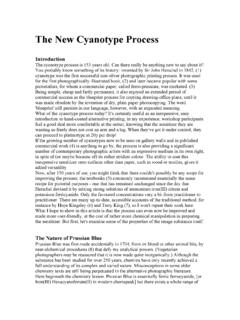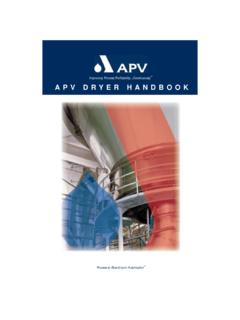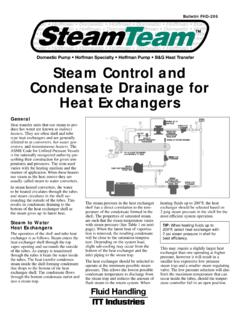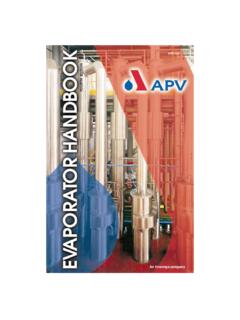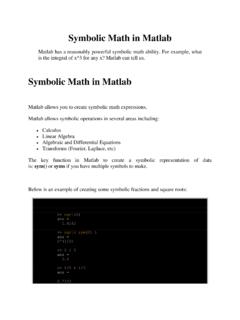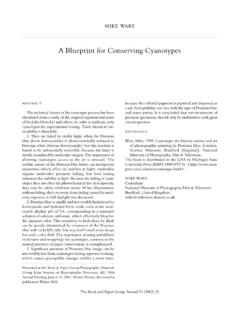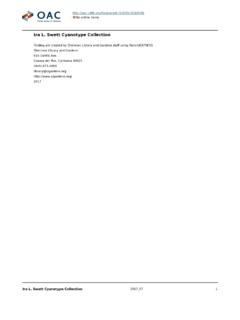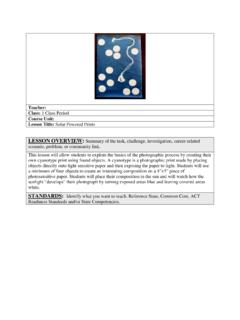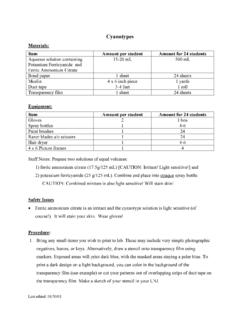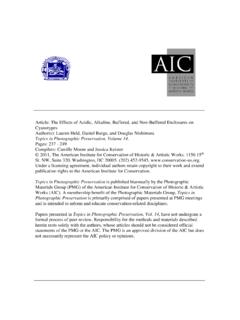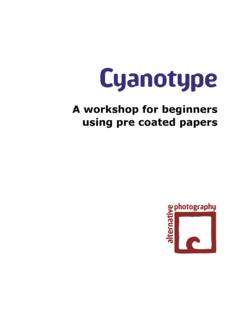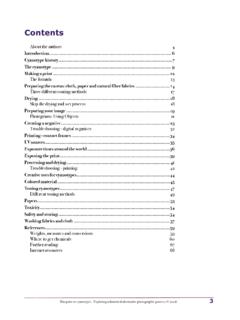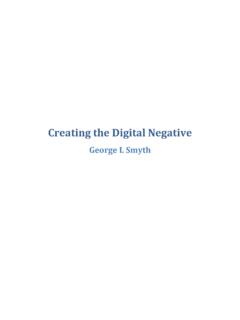Transcription of CYANOTYPE PROCESS - userpages.umbc.edu
1 National Museum of Photography, Film & Television BRADFORD West Yorkshire BD1 1NQ Telephone Facsimile World Wide Web +44 (0) 1274 202030 +44 (0) 1274 723155 The National Museum of Science & Industry comprises: National Museum of Photography, Film & Television Bradford National Railway Museum York Science Museum London & Wroughton INFORMATION SHEET NMPFT 2000 CYANOTYPE PROCESS Invented by Sir John Herschel in 1841, this simple PROCESS produces a continuous tone image of Prussian Blue using a sensitizing solution of ferric ammonium citrate and potassium ferricyanide.
2 These iron salts, when exposed to natural or artificial ultraviolet light, are reduced to their ferrous state, producing a high contrast blue image when oxidized. Oxidation is hastened by immersion in running water, which also washes away the unused iron salts. The PROCESS was eminently suited to its traditional role in reproducing technical drawings. Its most common use was in engineering and architecture until the advent of modern photocopiers. However, it was a versatile PROCESS and was used throughout the 19th century from Anna Atkins photograms of plants and seaweed for her books on botany (1843-55) to Henri LeSecq s still life studies of the 1850s.
3 Photographers at the end of the century used CYANOTYPE paper for proofing negatives. The PROCESS Solution A: grams ferric ammonium citrate (green) in distilled water to make 25 ml total Solution B: grams potassium ferricyanide in distilled water to make 25 ml total. Note: Today, distilled water is known as Purified water . Store separately in brown glass bottles, away from light. Filter before use, and mix in equal proportions A to B. Paper Suitable for many types of art papers. Try a good quality printmaking/drawing paper like Fabriano 5.
4 Coat in subdued tungsten light, and dry away from light and heat. Print by contact (in a printing frame with a full-sized negative) in sunlight or by a mercury vapour lamp until the shadows look bronzed. Exposure should be at least one stop more than required. Develop by immersing in running water, and wash until the chartreuse stain of the ferric ammonium citrate has completely disappeared. Over-washing will erode the image. A 3% bath of hydrogen peroxide will speed up oxidation. A few drops of bichromate added to wash water will increase contrast and can appear to intensify the printed image.
5 Avoid hydrochloric acid intensifier the acid can combine with the CYANOTYPE solution to produce cyanide gas. Working with the CYANOTYPE PROCESS Setting up (preparation) 1. Working Area Lighting for working: avoid daylight and fluorescent lighting, use low level tungsten light and limit total exposure. Working Surfaces: clean, and covered: newspapers, paper towels National Museum of Photography, Film & Television BRADFORD West Yorkshire BD1 1NQ Telephone Facsimile World Wide Web +44 (0) 1274 202030 +44 (0) 1274 723155 The National Museum of Science & Industry comprises: National Museum of Photography, Film & Television Bradford National Railway Museum York Science Museum London & Wroughton INFORMATION SHEET NMPFT 2000 Sensitizing Mixing chemical solutions: 2.
6 Measuring: clean dry paper for weighing dry chemicals, clean containers for measuring liquids 3. Labelling: identify, give proportions, date Coating chemical solutions: 4. Tape down paper 5. Brushes: Buckle s brush for smooth dense paper, soft hair brush for rough, porous paper or cloth Glass rod: for smooth, even coatings Roller: foam for cloth 6 & 7. Coating with a brush use horizontal and vertical brush strokes 8 & 9. Coating with a glass rod: use syringe to distribute solution: draw solution top to bottom Drying: 10. Drying: line and clothes pegs, boards or perspex Floor surface: protect with newspapers Storage: 11.
7 Protect from light, heat, damp. Limit duration of storage before exposure the coating will oxidize, and highlights will degrade. Exposure 12. Printing frames: traditional Home-made with bull clips, perspex, bubble wrap, melamine 13. Negative: beware chemical build-up on negative protect with mylar sheet or cling film 14. Step wedge for timing Basic guide: 125 watt uv lamp at 18 = 30 min Timing variations: humidity, build up of heat 16. Exposed print Development 17. In photographic tray, cold running water Fix 18.
8 Oxidation fixes the print National Museum of Photography, Film & Television BRADFORD West Yorkshire BD1 1NQ Telephone Facsimile World Wide Web +44 (0) 1274 202030 +44 (0) 1274 723155 The National Museum of Science & Industry comprises: National Museum of Photography, Film & Television Bradford National Railway Museum York Science Museum London & Wroughton INFORMATION SHEET NMPFT 2000 Drying 19. Hang on line or flatten against tilted, waterproof surface Note: To coat paper, try one of the following: A soft, broad brush (separate brushes for different processes).
9 A Buckle s brush : cotton wool tied with string the string is pulled through a glass or plastic tube so that the cotton wad forms a tuft at one end. This avoids the problem of contamination, as the cotton wool is discarded after each sensitization. A glass rod use a dropper or syringe to draw a line of sensitizer along the top of the rod. Hop the rod over the line and slowly draw down the paper to the bottom. Hop, then gently push to the top. Repeat until coated. Always tape the paper down to the table surface before coating.
10 Toning: Gallic-iron Purple lilac: Bleach print in 5% solution of ammonium hydroxide Wash thoroughly and let dry to allow ammonia to evaporate Tone in saturated solution of: gallic acid (1%) or tannic acid (20%) Wash, and dry quickly For a violet tinge, immerse in cold solution of borax Brown black Bleach 10 ml of 18% solution ammonium hydroxide 100 ml distilled water Toning: 10 gms tannic acid 500 ml distilled water Avoid use of sulphuric acid for greenish prints combination with CYANOTYPE solution may result in formation of cyanide gas.
